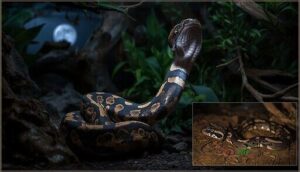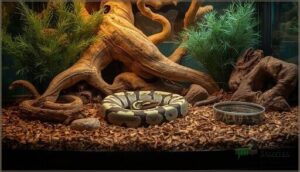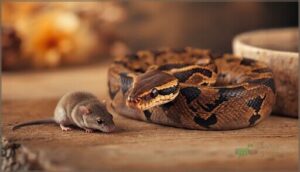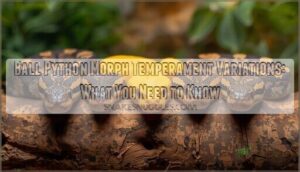This site is supported by our readers. We may earn a commission, at no cost to you, if you purchase through links.
You can’t buy a ball python at your local pet store without first sorting through a dizzying catalog of over 7,000 morph combinations—each with its own price tag, genetics, and visual appeal. This explosion of designer colors and patterns has transformed Python regius from a simple African grassland hunter into the most popular pet snake in the world.
But beneath those stunning scales lies a species worth understanding on its own terms: a stocky, docile python that’s spent millions of years perfecting survival strategies in sub-Saharan Africa’s toughest terrain. Whether you’re weighing your first snake purchase or fine-tuning care for an established collection, knowing what makes this species tick—from its burrowing instincts to its notoriously picky feeding habits—gives you the control and confidence to keep your ball python thriving for decades.
Table Of Contents
Key Takeaways
- Ball pythons are the smallest African python species with over 7,000 morph combinations available, making them the most popular pet snake worldwide due to their docile temperament and stunning visual variety.
- Proper captive care requires a 4x2x2 foot minimum enclosure for adults with precise temperature gradients (86-90°F warm side, 72-80°F cool side), 50-60% humidity, and 3-4 inches of substrate depth to replicate their natural burrowing behavior from African savannas.
- Most feeding problems and health issues stem from fixable husbandry mistakes rather than the snake itself—respiratory infections, shedding problems, and refusal to eat typically trace back to incorrect temperatures, humidity levels, or inadequate hiding spaces.
- With proper care, captive ball pythons live 15-30 years (sometimes reaching 50-62), far outlasting their 10-year wild lifespan, while wild populations face serious threats from habitat loss and illegal trade that have dropped collection rates in Benin from 5-10 snakes per day to less than one.
Ball Python Species Overview
Ball pythons have earned their spot as one of the most beloved pet snakes, and it’s not hard to see why. These African natives bring a calm temperament and stunning variety to the table, making them perfect whether you’re just starting out or you’ve been keeping reptiles for years.
Let’s break down what makes this species tick—from their scientific roots to the wild array of colors and patterns that set them apart from their python cousins.
Scientific Classification and Native Range
You’re looking at Python regius—the ball python’s official name, with “regius” nodding to its royal heritage as living jewelry for African rulers. This species sits within the genus Python, native to western and central Africa across over 2 million square kilometers.
Their taxonomic history places them as the smallest African python, with conservation status increasingly urgent due to habitat loss and wildlife trafficking threatening their species distribution. Understanding the wildlife conservation efforts is vital for protecting ball python populations.
Physical Characteristics and Morph Diversity
Ball python characteristics start with a stocky build—adults stretch 35 to 54 inches and weigh 1.3 to 3.6 pounds, with females larger than males, making them sexually dimorphic. Wild-type color patterns show dark brown blotches on lighter backgrounds, but ball python morphs explode this palette.
Over 7,000 morph combinations exist through trait inheritance—from albino to piebald—each governed by morph genetics affecting scale texture, iridescence effects, and pattern complexity. Breeders are constantly creating new color combinations through selective breeding.
Distinguishing Features From Other Python Species
Beyond morphs, you’ll notice ball pythons stand apart from other true python species in key ways. Size comparison puts them at a compact 1.5 meters max—dwarfed by reticulated pythons stretching 9.1 meters. Their constricting snake characteristics differ too:
- Rounder head shape versus triangular profiles in larger pythons
- Blunt, thicker tail appearance rather than slender tapers
- Rougher scale texture from fewer dorsal rows
- Calm temperament differences—they ball up defensively instead of striking aggressively
- African grassland habitat separating them geographically from Asian relatives
These snake species traits make ball python characteristics uniquely suited for captivity, driven by snake genetics favoring docility over confrontation.
Natural Habitat and Behavior
Understanding where ball pythons come from helps you create a better home for them in captivity. These snakes are native to specific regions of Africa, where they’ve adapted to life in grasslands, savannas, and forest edges—not deep jungles like many people assume.
Let’s look at their natural range, preferred habitats, and how they actually behave in the wild.
Geographic Distribution in Africa
You’ll find ball pythons across sub-Saharan West and Central Africa, from Senegal to Uganda. Their range spans over a dozen African countries, but habitat preferences keep them in grasslands and savannas—they avoid dense rainforests.
Population density varies dramatically: Ghana’s your export hub with high numbers, while Benin shows troubling range fragmentation and wildlife conservation concerns. These location patterns directly impact both wild populations and conservation trends you should know about.
Typical Environments and Burrowing Habits
In the wild, you’ll find ball pythons claiming savanna microhabitats—grasslands and open woodlands where rodent burrows and termite mounds provide underground refuges. They’re not diggers by nature; instead, they commandeer existing animal burrows for shelter.
This burrowing behavior isn’t laziness—it’s smart microclimate regulation. Below ground, humidity stays higher and temperatures more stable than the scorching surface, giving your ball python a habitat that allows for healthy shedding and thermoregulation.
Nocturnal Activity and Defensive Behaviors
Most of your ball python’s action happens once the sun sets—activity peaks sharply in late afternoon and early night, with exploration and hunting concentrated in the dark phase.
Housing matters: furnished terrariums enable climbing and basking, while racks can trigger repetitive pushing at barriers.
When threatened, you’ll see a defensive sequence—S-shaped coils, hissing, then a lightning-fast strike. Juveniles actually match viper-speed bites, though predation risk drops as they grow.
Ball Python Care Requirements
Setting up a proper home for your ball python doesn’t have to be complicated, but you need to get a few key things right from the start. Your snake’s enclosure is where it’ll spend its entire life, so the size, temperature, and setup matter more than you might think.
Let’s break down exactly what your ball python needs to stay healthy and comfortable.
Ideal Enclosure Size and Setup
Your ball python’s enclosure dimensions set the foundation for its entire life. Hatchlings thrive in 10-gallon setups, while adults demand at least 4 x 2 x 2 feet. Material choice matters—PVC retains heat 20% better than glass.
Add 3-4 inches of substrate depth like coconut coir for burrowing. Include two hides and secure latches that resist 50 pounds of force to prevent escapes.
Temperature, Humidity, and Lighting Needs
Proper thermal gradients separate survival from suffering. Set your warm hide at 86–90°F and cool side at 72–80°F using separate thermostats for each heat source—unregulated equipment causes burns.
Maintain 50–60% humidity with a digital hygrometer, raising it to 65–70% during shedding to prevent dysecdysis.
Add low-output UVB on a 10–12 hour cycle for vitamin D3 synthesis and disease prevention.
Essential Substrate and Hiding Options
Substrate depth matters—aim for 3–4 inches minimum to allow natural burrowing and stabilize humidity near 55%. Cypress mulch or coconut husk work best, while cedar causes dermatitis.
Place at least two hideaway boxes (one warm-side, one cool) matching your snake’s body length. Natural hides like cork bark and artificial options both reduce stress by 35%.
Clean moss weekly and replace substrate every 8–10 weeks to prevent scale rot in your terrarium setup.
Feeding and Nutrition for Ball Pythons
Getting your ball python’s diet right is one of the most important parts of keeping them healthy. In the wild, they’re opportunistic hunters that eat small mammals, but in captivity, you control what they eat and when.
Let’s break down what works best for feeding your snake, how often they need to eat, and how to handle the picky eating habits they’re famous for.
Diet in The Wild Vs. Captivity
Understanding how captive feeding differs from nature gives you real control over your snake’s health. Wild prey diversity includes birds, small mammals, bats, and even bushbabies—not just rodents. In contrast, your captive ball python diet centers on frozen rodents, which brings five critical shifts in feeding and nutrition for snakes:
- Feeding frequency: Wild adults eat roughly 10 meals yearly; captive schedules push 17–26, ramping up calorie intake and captive health risks like obesity.
- Prey size: Wild ball pythons ambush smaller, varied targets; you’re likely offering single prey at 10% body weight—higher energy per meal.
- Nutritional deficiencies: Commercial feeder rodents lack vitamin D and diverse minerals found in wild prey diversity, so supplement when skipping UVB.
- Rodent diet monotony: Wild specimens consume multiple prey types; your frozen rodents provide consistent but narrow nutrition, missing the breadth of wild feeding techniques.
- Energy balance: Reduced locomotion and reliable meals in captivity mean less burn, more storage—watch body condition closely to avoid fatty liver disease.
Align your feeding techniques with natural intermittence, not convenience, to keep your snake lean and thriving.
Appropriate Prey Types and Feeding Schedules
Now that you see the gap between wild and captive nutrition, you control the fix.
Feed hatchlings every 5–7 days on mice; juveniles get one rat weekly; adults thrive on 100–150 g frozen rodents every 10–21 days—or stretch to monthly with larger prey. Prey size should match 1.5–2 times midbody width.
That schedule dodges overfeeding risks while you introduce dietary variety through occasional quail or ASF rats.
Common Feeding Challenges and Solutions
Even with perfect feeding schedules, you’ll hit refusals—over 90% trace to husbandry, not appetite. Temperature swings and cramped quarters trigger most strikes. Before panicking, check your gradient and add hides.
Seasonal fasting happens, especially in older snakes; some fast 250+ days safely. If weight drops or breathing sounds wrong, suspect medical issues and get veterinary help fast.
Health, Lifespan, and Conservation
Keeping your ball python healthy means catching problems early and knowing what to watch for. Beyond day-to-day care, you’ll want to understand how long these snakes actually live and what threats they face in the wild.
Let’s break down the health issues you might encounter, what lifespan to expect, and why conservation matters for this species.
Common Health Issues and Preventive Care
Your ball python’s biggest enemies aren’t dramatic—they’re preventable. Respiratory infections (watch for open-mouth breathing), parasites from poor quarantine, shedding problems tied to low humidity, and anorexia from stress or wrong temperatures top the list.
Daily spot-cleaning, 50–60% humidity, proper hides, and routine veterinary checkups catch trouble early. Most snake health disasters stem from fixable husbandry mistakes, not bad luck.
Typical Lifespan in Captivity and Wild
Your ball python can outlive most dogs—captivity pushes their lifespan to 15–30 years versus roughly 10 in the wild. One Philadelphia Zoo individual hit 50; another at Saint Louis reached 62. Males sometimes edge past 30 years.
Ball pythons can outlive most dogs, living 15–30 years in captivity and occasionally reaching 50 or even 62
Growth patterns, genetics, and your husbandry all shape longevity. Proper temps (90–92°F basking), 50–60% humidity, and veterinary access turn “maybe” into decades.
Conservation Status and Threats to Wild Populations
Although the IUCN lists ball pythons as Near Threatened, West African populations face real pressure. Habitat Loss from mechanized farming shrinks savanna refuges, while Illegal Trade, Bushmeat Demand, and Ranching Practices pull breeding females from the wild. Climate Impacts threaten prey availability, and collectors in Benin now catch fewer than one snake per day—down from five to ten two decades ago.
Species conservation and Wildlife Protection efforts need your support through habitat preservation measures.
Frequently Asked Questions (FAQs)
Can ball pythons live together in one enclosure?
No, don’t house ball pythons together. Cohabitation stress, resource competition, and disease transmission create serious risks. Cannibalism can occur, and expert recommendations emphasize individual enclosures for proper reptile care and snake husbandry.
How do you breed ball pythons successfully?
You’ll need mature females over 1,500 grams and males around 600–800 grams.
Control temperatures carefully, track genetics with Punnett squares, and watch for reproductive health risks—dystocia affects females, while cloacal disease hits males hard.
What are signs of stress in ball pythons?
When silence screams louder than words, your ball python’s behavior tells the story. Watch for escape attempts, defensive posturing, refused meals, and restless pacing—these behavioral indicators reveal enclosure stress, handling stress, and underlying health manifestations requiring immediate attention.
Do ball pythons recognize their owners over time?
Ball pythons don’t recognize you as an individual. Scent discrimination studies show they habituate to predictable handling rather than forming bonds.
Stress responses decrease through familiarity, not true owner recognition—behavioral indicators reflect comfort, not cognitive identification.
How often should ball pythons shed their skin?
Young ball pythons shed roughly every 3–4 weeks during rapid growth. Adults usually shed every 4–6 weeks, though intervals beyond 8 weeks can be normal if your snake’s appetite and body condition remain stable.
Conclusion
Knowledge is half the battle—action is what keeps your snake species ball python thriving. You’ve learned the African roots, the morph explosion, and the care essentials that separate thriving snakes from struggling ones.
Now you control the environment, the feeding routine, and the health checks that add decades to your python’s life. Don’t second-guess yourself: trust the biology, stick to the fundamentals, and watch your confidence grow with every successful shed.













